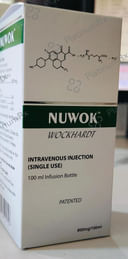Levonadifloxacin
Uses
Levonadifloxacin is used to treat bacterial skin infections.
How it Works
How Levonadifloxacin works: Levonadifloxacin functions by disrupting bacterial replication and inhibiting the growth of bacteria responsible for major skin infections.
Side Effects
Common side effects of Levonadifloxacin include application site reactions such as burning, irritation, itching, and redness.
Expert Advice
- Levonadifloxacin may cause constipation.
- Drink plenty of fluids and consume fiber-rich foods if you experience constipation.
- Stick to simple meals and avoid rich or spicy foods while taking Levonadifloxacin to prevent nausea.
- You may feel fatigued or dizzy after treatment with this medicine.
- Drive only if you are alert; omit driving or operating machinery if you feel dizzy.
Other Combinations
Related Medications
Salt Composition in both
Levonadifloxacin 500mg

Nuwok O 500mg Tablet 2s
Sun Pharmaceutical Industries Ltd.
Strip of 2 tablets
MRP
₹60.3

Emrok O 500mg Tablet 4s
Wockhardt Ltd.
Strip of 4 tablets
₹2,392.8
MRP ₹2,918.1
Top Brand
Salt Composition in both
Levonadifloxacin 800mg

Nuwok 800mg Injection 100ml
Wockhardt Ltd.
Vial of 100 ml
MRP
₹276.9

Emrok 800mg Injection 100ml
Wockhardt Ltd.
Bottle of 100 ml
₹3,199.8
MRP ₹3,720.8
Top Brand
Salt Composition
Levonadifloxacin 500mg

Emrok O 500mg Tablet 4s
Wockhardt Ltd.
Strip of 4 tablets
₹2,392.8
18% OFF
MRP ₹2,918.1
Salt Composition
Levonadifloxacin 800mg

Emrok 800mg Injection 100ml
Wockhardt Ltd.
Bottle of 100 ml
₹3,199.8
14% OFF
MRP ₹3,720.8
Salt Composition
Levonadifloxacin 400mg

Emrok 400mg Injection
Wockhardt Ltd.
Vial of 1 ml
MRP
₹1,664
Sorry, the substitute medicine is Currently Unavailable